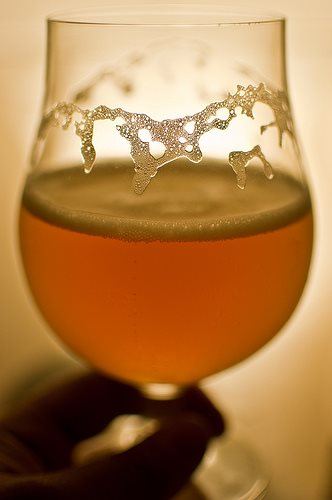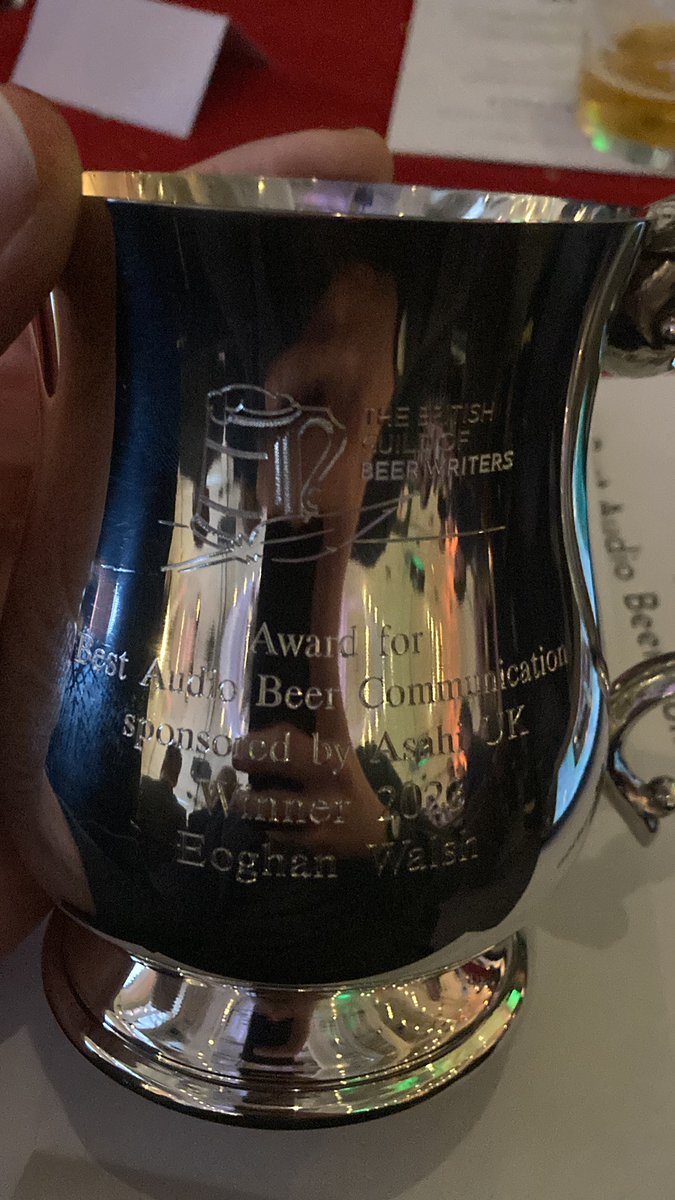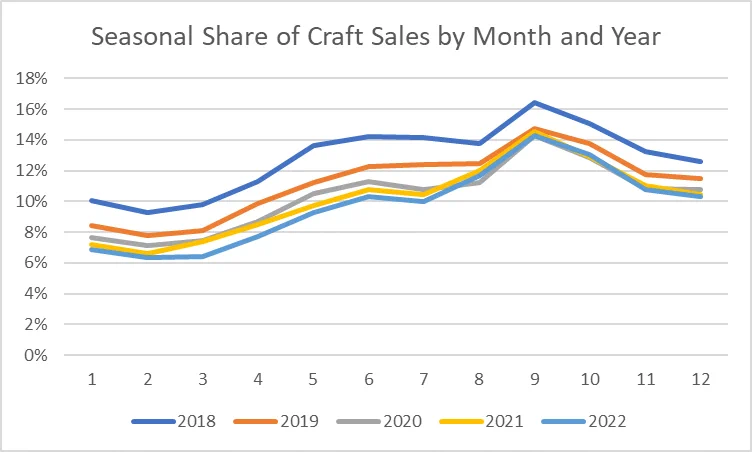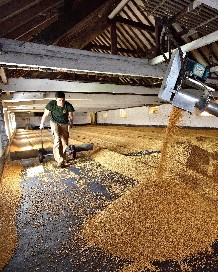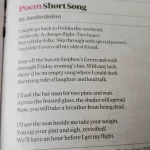Here we are. The second month of the year. Even though it sorta sucks around here, February is at least proof that dreary January isn’t forever. Sky watcher Jordan noticed, too. Sky watcher. I saw this weird blinding light up there just yesterday afternoon. It was strange. Everyone I know is looking forward to this month, solely to put January behind them. Was it that bad? It was. It really was. TGIF, baby. You know, January’s taking on a certain societal pong. It’s now the crappiest month of the year, isn’t it. Why? Well, perhaps as a first bit of evidence, Cookie puts his foot down about Dry January:
Boozing is part of culture. December is culturally a month of excessive consumption. January is always quiet. This has been a seasonal norm for centuries. Imagine the guy renting deckchairs on the beach, moaning that it’s quiet in winter. Hospitality is seasonal.
 That is a reasonable argument. At least a reasonable baseline. Do people believe it? There have been a number of unfortunate tales of businesses doing badly, blaming the times, blaming others and bad luck, blaming the general cutting back. Can we call these exuberance hangovers?* It is a now problem or a back then one? As this handy graph illustrates, there are even exuberences in some sorts of exuberence avoidance, like in the no/lo marketplace:
That is a reasonable argument. At least a reasonable baseline. Do people believe it? There have been a number of unfortunate tales of businesses doing badly, blaming the times, blaming others and bad luck, blaming the general cutting back. Can we call these exuberance hangovers?* It is a now problem or a back then one? As this handy graph illustrates, there are even exuberences in some sorts of exuberence avoidance, like in the no/lo marketplace:
The pattern was similar for spirits, with people paying more for no/lo spirits, on average, than standard spirits. Again, the gap has narrowed over time, after an initial ‘noisier’ period when the no/lo spirits market was extremely small. There was relatively little difference between the prices paid for no/lo and standard ciders in pubs, bars, clubs, and nightclubs, with no/lo cider being 5% more expensive on average in 2021. Wine was notably different to the other categories, with prices paid for no/lo wine remaining consistently around 25% lower than standard wine.
You are going to have to read that article for the graph to make any sense. But it looks so good I am just leaving it there. I also thought of this question of inordinate enthusiam when I read Jessica Mason‘s piece on the response of certain minority shareholders of Black Sheep Brewing at the brewery’s reorganization by new investor the private quity firm, Breal:
Regarding Breal’s interests in Black Sheep, Sturdy admitted in his letter that he was “glad that most of the jobs of the employees in the company were saved” despite news of redundancies and closures circulating, but queried “how the directors are fit and proper persons to run the new company”. Describing the issue, he highlighted… “most of us are not rich, but are hard working loyal people, including employees of the old company, farmers, licensees and local tradesmen”. He said: “Coincidentally the CEO owned no shares in the company at this time. The MD and export director owned 6,256 and 11,050 shares respectively” and added: “In my view these deals should be outlawed.”
I mean I get it – and there are the empty pocketed suppliers to think of too. A very January-ish story. The month of general public lament. I noticed that The New York Times published stories on the dangers to mental health by taking lots of things as well as on the various other dangers of cannabis however taken. Having given up on dope around 1981, I am a bit amazed that this is newsworthy because it is simply so. Not news. But then the same paper of record published something I found actually new and noteworthy: businesses responding to the challenges of these times head on, by undertaking all sorts of intentional narrowing in beer selection:
“I don’t need five pilsners,” said Olivier Rassinoux, the vice president of restaurant and bar at Patina Restaurant Group, which is headquartered in Buffalo. At Patina’s Banners Kitchen & Tap, a 72-tap sports bar in Boston, the bar turned two taps over to kegged margaritas last year and plans to add additional draft cocktails and wine. Max’s Taphouse, a Baltimore beer institution since 1986, is buying smaller kegs to fill its 113 taps and reducing its extensive cellar of large-format bottled beers. They’ve fallen out of fashion, and lingering bottles are “turning into nostalgic keepsakes,” said Jason Scheerer, the general manager.
Ahhh… Max’s. Got the kid a sweet tee there in 2012. He was 12. Fits him now. Better to be clever and cautious than closed. Relatedly, in his newsletter Everyday Drinking, after describing another sort of exuberance (his own recent training as a honey sommelier care of the American Honey Tasting Society) Jason Wilson posed the question that has parallel this era of gratification through certification:
…over the past decade, there’s been a creeping wine-ification in every realm of gourmet endeavor. Now, in our era of hyper-credentialism, there’s almost no sphere of connoisseurship without a knowledgeable, certified taste expert, someone who’s completed serious coursework and passed an exam. A two-day tea sommelier certification course (followed by eight weeks of home study) from the International Tea Masters Association costs $1,725. A five-day olive oil sommelier certification program in New York costs $2,800. A nine-day water sommelier certification program at the Doemens Academy in Germany costs more than $3,000 (travel not included). These programs prepare you to be a taste authority, a sensory expert, an arbiter and evangelist in the field, though you’re likely not producing anything.
That’s a lot. Was it also too much? Did we ever need all these niche claims to authority? Enthusiasts with paper. Is that also an exuberance passing out of fashion? Didn’t we have enough of authority when we decided to take a pass on the off-taste lessons and beer pairing dinners? Speaking of excesses, Stan published his latest edititon of Hop Queries and gave a vivid picture of of the excess hop production facing the industry:
A surplus of hops continues to hang like a dark cloud over producers and suppliers in the Northwest. Last week at the American Hop Convention, John I. Haas CEO Tom Davis told growers that as a group they need to remove an additional 9,000 to 10,000 acres of aroma hops from of production. Idling about 6,000 acres (including approximately 9,000 acres of aroma hops) in 2023 had no meaningful impact on inventory reduction. The estimated 35-to-40-million-pound aroma hop surplus has not changed… In the Czech Republic, the third largest hop producing country in the world, growers harvest about 12,000 acres, almost all of them planted with aroma varieties. Eliminating 10,000 acres would be much like eliminating all Czech production. It would reduce acreage to not much more than farmers strung in 2015…
Very much conversely, Lucy Corne had an excellent piece published in GBH about a small, succinct and successful Ontario-Rwanda project which I knew a bit about when it was first started by Beau’s Brewing** in far eastern Ontario – but one which I had lost track before it took a distinct turn just about 17 words after this part of the story below:
Beauchesne thought it sounded like a good fit, though it would present obvious challenges. “It was so much more out of our comfort zone than we had intended,” he says. “We flew down to Rwanda to meet Fina and to check out the business climate. The last thing we wanted was to start a project that had no chance of succeeding. I came back inspired. And also scared shitless.” Burying his fears, Beauchesne dove into the project, launching a crowdfunding campaign which reached its $100,000 target within two months. Over the next year, locations were scouted around Kigali, business plans were drawn up, and the team at Beau’s started working on recipes using traditional Rwandan brewing ingredients, including cassava and bananas.
And the very epitome of a balanced approach, the Tand published a neat a tidy story of a beer crawl in London the highligth of which was his vignette of busy normality:
This is an Irish style pub – without the umpteen intrusive televisions – and was severely rammed with after work drinkers. Nonetheless, the service was swift and cheerfully efficient, but it was so busy I could see little of the bar. I’m pretty sure there was no cask and I wouldn’t have had it anyway here, as everyone seemed to be guzzling Guinness. If you can’t beat them, join them is sometimes not a bad motto. The Guinness was the best I have ever had in London. Perhaps a tad cold, but certainly the best since I was last in Belfast, and at least a match for Mulligans in Manchester. So we had another. Seemed the right thing to do, especially since the same barman who’d served me, when collecting glasses, saw us standing in a corner and shifted some office workers who’d purloined the table that should have been there. Thus seated, we enjoyed the busy scene even more.
Note: one sort of beer, not 113 taps. And what a great heaving description. Balance was also a theme in Lily Waite‘s piece in Pellicle this week, a portrait of Ideal Day Family Brewery, a back to basics brewery situated in a rural English business cooperative:
Set in a central run of low-slung converted stone barns around a well-tended courtyard, and a number of other slightly less hashtag-aesthetic, more utilitarian farm buildings around the site, the various businesses work together in harmony. The hospitality centred ones all invariably use produce from the farm: the restaurant’s whole ethos is farm-to-table; the cafe uses and sells the produce; James uses wheat and barley grown on the farm and various miscellany from the kitchen garden in his beers.
And in his newsletter Episodes of My Pub Life, David Jesudason reflected on being included in a Deutsche Welle broadcast to share his thoughts on speakin of how things really were, looking back with clarity through his studies of the imperial roots of IPA while giving us a bit of an insight into his process:
I’m really proud of this podcast put together by DW (the German equivalent of the BBC) on the thorny subject of the IPA’s colonial legacy. It came about after the producer Sam Baker stumbled upon my first piece for Good Beer Hunting, which changed how we looked at how IPAs were marketed. (I have mixed feelings about that article as none of my subsequent ones for GBH ever reached the same mass audience.) The Don’t Drink the Milk podcast seeks to explain a subject ubiquitous but misunderstood. The IPA episode had a huge scope with numerous recordings in different countries but is easily accessible for listeners new to the subject of empire. It placed mine and beer writer Pete Brown’s stories central to the narrative and even gave international listeners a flavour of what the Gladstone in Borough is like. It’s what I want Radio 4 to be when I switch it on – and then quickly turn off as I feel alienated by a lot of the subject matter...
Reality checked. Finally and as reported in December, Jeff was invited to speak at a beerfest in Budapest. In his reportage from the scene, he posted something like that chapter in the middle of Hobbes’ Leviathan that cuts so quickly to the point that the rest of the book is a bit unnecesary. In sum, it is a summary – but to my mind some bits might need a wee edit like this:
What’s different is the internet—now information moves far more quickly. In the U.S., it took brewers 15-30 years (depending on the region) to develop native beer. Brewers weren’t even making the beer they imitated properly because most had never been to Europe and they had no information about how to make those beers.
There’s a couple of things. First, the US has given birth to many beer styles that would please any nativist. The cream ales, cream beers, steam beers or (the most obvious winner of the race… if it were a race) macro lagers have each had their day just as Pete’s Wicked Ale and then extreme beers have more recently. And Albany, Kentucky and California have all sent their distinct offspring out into the world. Which is why I prefer “regional” to “national” as the adjective in these matter.
Second, even though there weren’t 100 microbreweries and brewpubs in the USA until around 1988 (making them an oddity for most of the decade) in the 1980s there is no question that US craft brewers had access to plenty of information about brewing the good beer they were imitating. There were imported books and magazines as well as beer supply stores and beers of the world bars as meeting places. We see from one document that there were festivals like the Great American Beer Festival in 1982 at Boulder Colorado where Fred Eckhardt, Michael Jackson, Ken Grossman, Michael Lewis, Bill Newman and Charlie Papazian met with British brewers who all spoke and no doubt spoke with each other and anyone else who cared to listen. We learn from another primary record from 1986 that Michael Jackson was delighted with the Winter Ale brewed by Bill Newman at Albany, New York. Newman had learned his stills during the months in 1979 he worked under the tutelage of the father of the British independent brewery movement, the recently departed Peter Austin, at his Ringwood Brewery in Hampshire England. Alan Pugsley of Shipyard also trained under Austin and then trained others. Greg Noonan later of the Vermont Brewery was out there researching his first book “Brewing Lager Beer” before 1986, the same year the Buffalo Brewpub was opened by Kevin Townsell who “imports his malt from England via Canada, and gets hops, a fragrant vine that determines aroma and bitterness levels, from the Yakima Valley.” And, of course, Bert Grant had been in the brewing trade since the 1940s working his way up at E.P. Taylor’s Carling brewery in Toronto before later emigrating and opening Yakima Brewing in 1982. Suffice it to say, they all had the information. And shared it. And understood what they were doing.
That’s a lot. The clear and unclear. The plain and the cluttered. The unexpected and the shoulda seen coming. Ways that are fair while others are rough. Enough!! Once again… roll the credits… well, the credits, the stats the recommends and the footnotes. There is a lot going on down here and, remember, ye who read this far down, look to see if I have edited these closing credits and endnotes (as I always do), you can check out the many ways to find good reading about beer and similar stuff via any number of social media and other forms of comms connections. This week’s update on my emotional rankings? Facebook still in first (given especially as it is focused on my 300 closest friends and family) then we have BlueSky (up again to 116 rising up to maybe… probably… likely pass Mastodon (static at 911) in value… then the seemingly doomed trashy Twex (4,437 – down one) hovering somewhere above or around my largely ignored Instagram (down to 163), with sorta unexpectly crap Threads (43) and not at all unexpectedly bad Substack Notes (1) really dragging up the rear – and that deservedly dormant Patreon presence of mine just sitting there. I now have admitted my dispair for Mastodon in terms of beer chat, relocated the links and finally accept that BlueSky is the leader in “the race to replace” Twex even while way behind.
Fear not! While some apps perform better than other we can always check the blogs, newsletters and even podcasts (really? barely! This era’s 8-track tapes!)*** to stay on top of things including the proud and public and certainly more weekly recommendations in the New Year from Boak and Bailey every Saturday and Stan back at his spot for 2024 on Mondays. Look at me – I forgot to link to Lew’s podcast. Fixed. Get your emailed issue of Episodes of my Pub Life by this year’s model citizen David Jesudason on the odd Fridays. And Phil Mellows is at the BritishBeerBreaks. Once a month, Will Hawkes issues his London Beer City newsletter and do sign up for Katie’s now revitalised and wonderful newsletter, The Gulp, too. Ben’s Beer and Badword is back with all the sweary Mary he can think of! And check out the Atlantic Canada Beer Blog‘s weekly roundup. There is new reading at The Glass which is going back to being a blog in this weeks best medium as message news. Any more? Yes! Check to see the highly recommended Beer Ladies Podcast. That’s quite good. And the long standing Beervana podcast . There is the Boys Are From Märzen podcast too and Ontario’s own A Quick Beer. There is more from DaftAboutCraft‘s podcast, too. All About Beer has introduced a podcast… but also seems to be losing steam. And there’s also The Perfect Pour. Plus follow the venerable Full Pint podcast. And the Craft Beer Channel on Youtube and remember BeerEdge, too, and The Moon Under Water… if you have $10 a month for this sort of thing… I don’t. Pete Brown’s costs a fifth of that. There was also the Beer O’clock Show but that was gone after a ten year run but returned renewed and here is the link!
*any number of the misheard lyrics of “Video Killed the Radio Star” may apply – we did country wine! Plus I knew a guy called Hubert. That explains everything.
**Disclosure: Steve B has been in my house at least twice and drank my beer…
***Thesis: podcasts and newsletters are a great way to minimize correction, criticism and citation by others so… playgrounds for affirmation. Antithesis: then why do I /you quote from them, numbskull?


